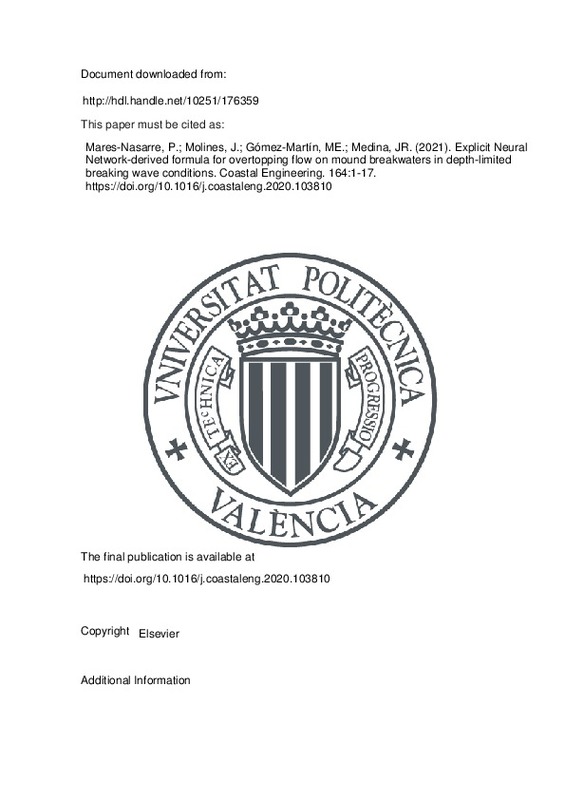JavaScript is disabled for your browser. Some features of this site may not work without it.
Buscar en RiuNet
Listar
Mi cuenta
Estadísticas
Ayuda RiuNet
Admin. UPV
Explicit Neural Network-derived formula for overtopping flow on mound breakwaters in depth-limited breaking wave conditions
Mostrar el registro sencillo del ítem
Ficheros en el ítem
| dc.contributor.author | Mares-Nasarre, Patricia
|
es_ES |
| dc.contributor.author | Molines, Jorge
|
es_ES |
| dc.contributor.author | GÓMEZ-MARTÍN, M. ESTHER
|
es_ES |
| dc.contributor.author | Medina, Josep R.
|
es_ES |
| dc.date.accessioned | 2021-11-05T14:09:09Z | |
| dc.date.available | 2021-11-05T14:09:09Z | |
| dc.date.issued | 2021-03 | es_ES |
| dc.identifier.issn | 0378-3839 | es_ES |
| dc.identifier.uri | http://hdl.handle.net/10251/176359 | |
| dc.description.abstract | [EN] Sea level rise due to climate change, as well as social pressure to decrease the visual impact of coastal structures, have led to reduced crest freeboards, and this increases the overtopping hazard. In previous studies, pedestrian safety during overtopping events was assessed considering the overtopping layer thickness (OLT) and the overtopping flow velocity (OFV). This study analyzed the statistics of OLT and OFV on mound breakwaters without crown walls during severe wave storms. Small-scale 2D physical tests were conducted on mound breakwaters with dimensionless crest freeboards between 0.29 and 1.77, testing three armor layers (single-layer Cubipod (R), and double-layer cubes and rocks) in depth-limited breaking wave conditions and with two bottom slopes. Neural Networks were used to develop new estimators for the OLT and OFV exceeded by 2% of the incoming waves with a high coefficient of determination (0.866 < R-2 < 0.876). The best number of significant figures in the empirical coefficients of the new estimators was determined according to their variability. The 1 parameter Exponential and Rayleigh distribution functions were proposed to estimate the extreme values of OLT and OFV with 0.803 < R-2 < 0.812, respectively. | es_ES |
| dc.description.sponsorship | The authors thank the three anonymous reviewers for their comments and suggestions. The authors acknowledge the financial support from the Spanish Ministerio de Economia y Competitividad and Fondo Europeo de Desarrollo Regional (FEDER) under grant RTI2018-101073-BI00. The first author was also financially supported through the FPU program (Formacion de Profesorado Universitario) funded by the Spanish Ministerio de Educacion, Cultura y Deporte under grant FPU16/05081. The authors thank Debra Westall for revising the manuscript. | es_ES |
| dc.language | Inglés | es_ES |
| dc.publisher | Elsevier | es_ES |
| dc.relation.ispartof | Coastal Engineering | es_ES |
| dc.rights | Reconocimiento - No comercial - Sin obra derivada (by-nc-nd) | es_ES |
| dc.subject | Mound breakwater | es_ES |
| dc.subject | Wave overtopping | es_ES |
| dc.subject | Overtopping layer thickness | es_ES |
| dc.subject | Overtopping flow velocity | es_ES |
| dc.subject | Depth-limited breaking wave conditions | es_ES |
| dc.subject | Cubipod (R) | es_ES |
| dc.subject.classification | INGENIERIA E INFRAESTRUCTURA DE LOS TRANSPORTES | es_ES |
| dc.title | Explicit Neural Network-derived formula for overtopping flow on mound breakwaters in depth-limited breaking wave conditions | es_ES |
| dc.type | Artículo | es_ES |
| dc.identifier.doi | 10.1016/j.coastaleng.2020.103810 | es_ES |
| dc.relation.projectID | info:eu-repo/grantAgreement/AEI/Plan Estatal de Investigación Científica y Técnica y de Innovación 2017-2020/RTI2018-101073-B-I00/ES/ESTABILIDAD HIDRAULICA Y TRANSMISION DE DIQUES ROMPEOLAS HOMOGENEOS DE BAJA COTA DISEÑADOS A ROTURA POR FONDO/ | es_ES |
| dc.relation.projectID | info:eu-repo/grantAgreement/MECD//FPU16%2F05081/ES/FPU16%2F05081/ | es_ES |
| dc.rights.accessRights | Abierto | es_ES |
| dc.contributor.affiliation | Universitat Politècnica de València. Departamento de Ingeniería e Infraestructura de los Transportes - Departament d'Enginyeria i Infraestructura dels Transports | es_ES |
| dc.contributor.affiliation | Universitat Politècnica de València. Instituto del Transporte y Territorio - Institut del Transport i Territori | es_ES |
| dc.description.bibliographicCitation | Mares-Nasarre, P.; Molines, J.; Gómez-Martín, ME.; Medina, JR. (2021). Explicit Neural Network-derived formula for overtopping flow on mound breakwaters in depth-limited breaking wave conditions. Coastal Engineering. 164:1-17. https://doi.org/10.1016/j.coastaleng.2020.103810 | es_ES |
| dc.description.accrualMethod | S | es_ES |
| dc.relation.publisherversion | https://doi.org/10.1016/j.coastaleng.2020.103810 | es_ES |
| dc.description.upvformatpinicio | 1 | es_ES |
| dc.description.upvformatpfin | 17 | es_ES |
| dc.type.version | info:eu-repo/semantics/publishedVersion | es_ES |
| dc.description.volume | 164 | es_ES |
| dc.relation.pasarela | S\422907 | es_ES |
| dc.contributor.funder | MINISTERIO DE EDUCACION | es_ES |
| dc.contributor.funder | AGENCIA ESTATAL DE INVESTIGACION | es_ES |
| dc.contributor.funder | European Regional Development Fund | es_ES |
| dc.subject.ods | 17.- Fortalecer los medios de ejecución y reavivar la alianza mundial para el desarrollo sostenible | es_ES |
| dc.subject.ods | 03.- Garantizar una vida saludable y promover el bienestar para todos y todas en todas las edades | es_ES |
| dc.subject.ods | 09.- Desarrollar infraestructuras resilientes, promover la industrialización inclusiva y sostenible, y fomentar la innovación | es_ES |
| dc.subject.ods | 14.- Conservar y utilizar de forma sostenible los océanos, mares y recursos marinos para lograr el desarrollo sostenible | es_ES |







![[Cerrado]](/themes/UPV/images/candado.png)

